Bioplastic PET breaks down significantly faster than fossil-based plastic PET, often degrading within months to years under industrial composting conditions. Fossil plastic PET can persist in the environment for hundreds of years, contributing to long-term pollution and microplastic formation. Bioplastic degradation reduces environmental impact by minimizing landfill accumulation and promoting a circular economy through improved biodegradability.
Table of Comparison
| Aspect | Bioplastic Degradation | Fossil Plastic Degradation |
|---|---|---|
| Material Source | Renewable biomass (e.g., corn, sugarcane) | Non-renewable petroleum-based |
| Degradation Time | Months to years (typically 6-12 months) | Hundreds to thousands of years |
| Degradation Process | Biodegradation by microbes under composting or soil conditions | Photooxidation and slow microbial degradation under limited conditions |
| Environmental Impact | Lower carbon footprint, reduced microplastic pollution | High carbon footprint, persistent microplastic pollution |
| End Products | Biomass, CO2, water | Toxic residues, microplastics |
| Disposal Requirements | Industrial composters preferred, some home compostable | Landfill, incineration, recycling (limited efficiency) |
Understanding Bioplastic and Fossil Plastic: Key Differences
Bioplastic degradation occurs significantly faster than fossil plastic degradation, often breaking down within months under specific environmental conditions, while fossil plastics can persist for hundreds of years due to their stable polymer structures. Bioplastics, derived from renewable biomass such as corn starch or sugarcane, undergo biodegradation through microbial activity, whereas fossil plastics, made from petroleum-based polymers, resist microbial decomposition. Understanding these differences highlights bioplastics' potential to reduce persistent plastic pollution and enhance sustainability in waste management.
Chemical Composition and Its Impact on Degradation
Bioplastics consist primarily of natural polymers such as polylactic acid (PLA) and polyhydroxyalkanoates (PHA), which contain ester bonds that are susceptible to hydrolysis and enzymatic breakdown, accelerating their degradation compared to fossil-based plastics composed of long-chain hydrocarbons like polyethylene and polypropylene. The chemical structure of fossil plastics, characterized by stable carbon-carbon bonds, contributes to their persistence and resistance to microbial activity, leading to prolonged environmental accumulation. In contrast, the biodegradable nature of bioplastics stems from their bio-based chemical composition, facilitating faster decomposition under industrial composting conditions and reducing plastic pollution.
Environmental Conditions Influencing Degradation Rates
Bioplastic degradation rates vary significantly depending on environmental conditions such as temperature, moisture, and microbial activity, with higher humidity and temperature accelerating breakdown in composting environments. In contrast, fossil plastics often degrade over centuries due to resistance to microbial enzymatic action and limited biodegradability under natural conditions. Factors such as UV exposure can enhance fragmentation in fossil plastics, but do not contribute significantly to complete mineralization compared to bioplastics designed for biodegradability.
Biodegradation Mechanisms of Bioplastics
Bioplastics primarily degrade through enzymatic hydrolysis, microbial assimilation, and polymer chain scission, enabling faster biodegradation compared to fossil plastics, which often resist microbial attack due to their stable carbon-carbon bonds. The presence of ester or amide linkages in bioplastics facilitates enzymatic breakdown by microorganisms, leading to mineralization into carbon dioxide, methane, and biomass under composting conditions. Fossil plastics typically rely on photodegradation and thermal oxidation mechanisms, resulting in fragmentation rather than complete biodegradation, causing persistent environmental pollution.
Fossil Plastic Breakdown: Physical and Chemical Processes
Fossil plastic degradation occurs through physical processes such as UV radiation exposure, mechanical abrasion, and thermal stress, which cause the polymer chains to break down into smaller fragments. Chemical processes including oxidation, hydrolysis, and photodegradation further alter the molecular structure, leading to the formation of microplastics and the release of toxic additives. These combined physical and chemical breakdown mechanisms result in long-lasting environmental persistence and harmful ecological impacts compared to the more rapid biodegradation of bioplastics.
Comparative Analysis: Speed of Degradation
Bioplastic degradation occurs significantly faster than fossil plastic degradation due to the natural polymer composition of bioplastics, which microorganisms can more readily break down within months to a few years. In contrast, fossil plastics derived from petroleum can take hundreds to thousands of years to degrade, primarily because their complex hydrocarbon structures resist microbial attack. This marked difference in degradation speed highlights bioplastics as a more environmentally sustainable option for reducing long-term plastic pollution.
Microplastic Generation: Bioplastics vs Fossil Plastics
Bioplastic degradation typically results in fewer microplastics compared to fossil plastic, as bioplastics like polylactic acid (PLA) break down more completely under industrial composting conditions. Fossil plastics, such as polyethylene and polypropylene, degrade slowly, fragmenting into persistent microplastics that accumulate in the environment and pose ecological risks. The reduced microplastic generation from bioplastics enhances their potential as a sustainable alternative to conventional plastics, mitigating long-term pollution.
End-of-Life Scenarios: Composting, Landfills, and Oceans
Bioplastic degradation significantly outpaces fossil plastic in composting environments, breaking down into non-toxic components within months due to microbial activity, whereas fossil plastics persist for centuries. In landfills, bioplastics may partially degrade anaerobically, producing methane, but fossil plastics remain largely inert, contributing to long-term pollution. In ocean ecosystems, bioplastics degrade faster through microbial biodegradation and photodegradation, reducing marine pollution compared to fossil plastics which fragment into microplastics with detrimental ecological impacts.
Ecological Impacts of Degradation Products
Bioplastic degradation typically results in less toxic byproducts such as water, carbon dioxide, and biomass, which significantly reduce soil and water pollution compared to fossil plastic degradation. Fossil plastics often release persistent microplastics and harmful chemicals like phthalates and BPA, contributing to ecosystem disruption and bioaccumulation in wildlife. The ecological impact of bioplastic degradation products is generally lower, promoting safer nutrient cycling and less adverse effects on terrestrial and aquatic organisms.
Future Prospects: Innovations in Biodegradable Materials
Innovations in biodegradable materials are advancing the future prospects of bioplastic degradation by enhancing the efficiency and environmental compatibility of these materials compared to fossil plastic degradation. Enzymatic technologies and microbial engineering are being developed to accelerate bioplastic breakdown in natural environments, reducing persistence and microplastic pollution. Future trends include designing bioplastics with tailored degradation rates and integrating sustainable feedstocks, which positions bioplastics as a key solution in addressing plastic waste challenges globally.
Bioplastic degradation vs Fossil plastic degradation Infographic

 materialdif.com
materialdif.com